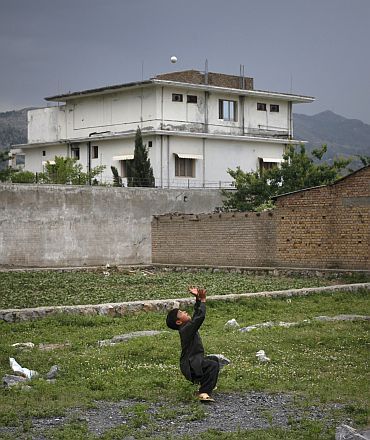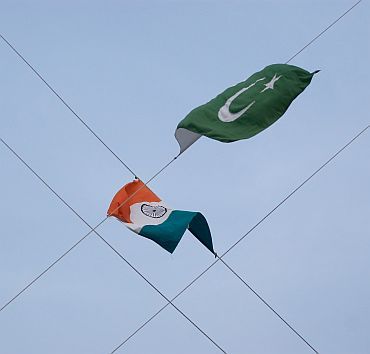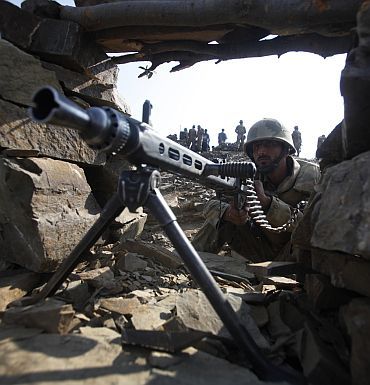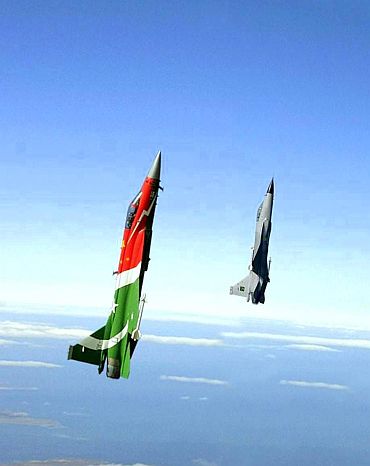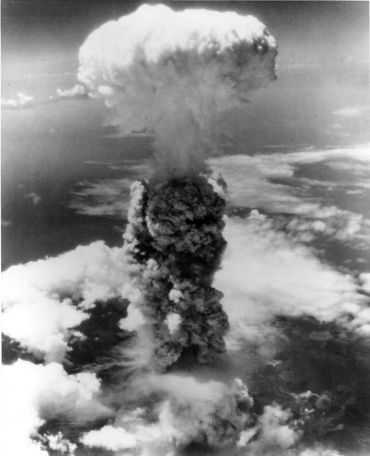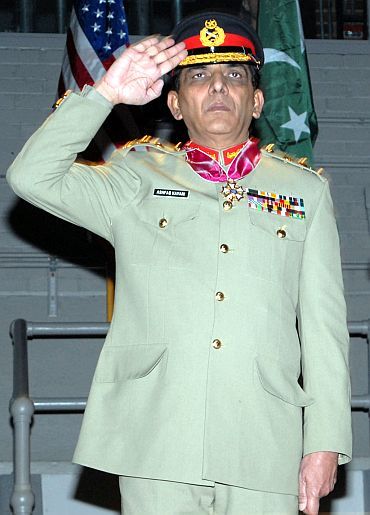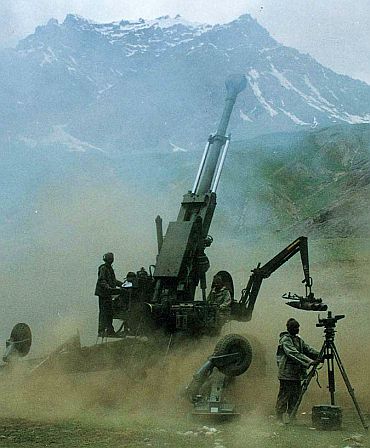 | « Back to article | Print this article |
Why an Indian threat to Pakistan is a myth
India has neither the intent nor the capability to pose a major threat to Pakistan. But the bogey of an India threat is kept alive in Pakistan mainly to help the military to ensure it relevance and dominance of the country, says Colonel (Dr) Anil Athale (retd)
This is season for busting long held myths. The Abbottabad raid by the Americans without the apparent knowledge of Pakistanis and Osama bin Laden's long stay there in a garrison town has exploded the myth of the Inter Services Intelligence as the world's 'premier' spy outfit.
Though this was more a creation of the lazy Indian media, it had acquired a life of its own. In reality, the ISI has been a major failure. It has witnessed a number of attacks on its own offices in Pakistan and terrorist attacks on many targets, the latest being the one on a major naval aviation base near Karachi. The truth is that the ISI's reputation was built on the many successful operations it carried out in/against India.
But these attacks could only be carried out because the ISI had a huge support base in India in the shape of organisations like the Students Islamic Movement of India, Indian Mujahideen, Ahle Hadith and the Tabiligi Jamaat. When bereft of this kind of support in its own country, the ISI has moved from blunder to blunder.
But the mother (and father) of all myths is the notion of 'perennial Indian security threat to Pakistan'. This myth has enabled the Pakistan Army to milk their country dry of all resources and also keep a firm grip on power by promoting fear psychosis. It is time cold military logic is brought to bear on this.
Click on NEXT to read further...
India and Pakistan: The military equation
Threat perception is a sum total of capability plus intention. Let us take intention first. Except for a tiny fringe element, no major political party in India has any interest in undoing Partition.
It is not out of any charity but due to the fact that addition of turbulent, violent 180 million people to India's existing billion is not a prospect that any Indian relishes.
Given the dismal socio-economic and educational statistics and the mess that Pakistan is, no sane Indian wants that part of undivided India to become part of India again.
Pakistanis could point out to the Indian intervention in erstwhile East Pakistan, now Bangladesh or Sri Lanka (the Indian Peace Keeping Force episode) as evidence of Indians' ill intentions. It is necessary to point out the fact that Bangladesh is an independent country today and there is not a single Indian soldier or Indian base either there or in Sri Lanka.
After the task of sending back the refugees was achieved, India withdrew from Bangladesh. The Sri Lankans were sceptical of Indian intentions, so much so that the then President R Premadasa even collaborated with the Liberation Tigers of Tamil Eelam. Yet even the most anti-Indian Sri Lankans today accept that India made great sacrifices and left on its own.
Ruling a hostile country of 180 million is beyond India's capability
It is time to remind the Pakistanis that India returned the Shakkargarh area as well as areas in Sindh after the 1971 war along with the 92,000 prisoners of war.
If India, like Israel after 1967 war, had intentions to grab Pakistani land, it could well have continued to dilly-dally its return!
Ruling a hostile country of 180 million is beyond the capability of India and there are no attractive economic gains or scarce resources like oil in Pakistan that could attract India. There is no earthly 'interest', economic, political or military that would serve by India conquering Pakistan.
The oft-heard argument of Pakistani military leaders and security experts is that they plan their security based not on 'intent' but on capability. The logic is that intent can change any time.
Accepting this argument, though a dubious one (for instance India has obvious military capability to attack and capture all other six countries in South Asia but no 'interest' and therefore no intent to do so), let us examine the military balance between India and Pakistan.
Indian Army is 1.1 million strong, but...
The Indian Army is 1.1 million strong compared to the 0.55 million strong Pakistan Army. But it must be noted that at least 1/3 of this force is needed at all times to guard the nearly 2,000 km of India-Tibet border.
Even during the 1971 war when the Soviet Union had deployed close to 44 divisions against China (from the normal three divisions) on the Amur-Ussuri river border, India could not withdraw much of the forces from North.
In case of any future conflict between India and Pakistan, only around 8 lakh troops of India would be available against Pakistan to match 4 to 5 lakh granting that around 1 lakh troops are on the Afghan border. This is much less than the normal three times superiority that is needed for a successful aggression.
Pakistan has far better equipment than the Indians
Modern warfare is technology intensive. In terms of sophistication, thanks to the American supplies post 9/11, in most of the fields, Pakistan has far better equipment than the Indians. The table below gives an idea of the various major armaments of both.
|
| Old tanks | Modern tanks | Anti-tank guns/missiles | Artillery guns |
| India | 3673 | 444 | 3000 | 10,758 |
| Pakistan | 1821 | 835 | 14400 | 4521 |
Source: Sipri and IISS.
Thus while India has a certain edge in overall number of tanks, in terms of sophistication, Pakistan is actually ahead of India. Some years ago, the Indian Army chief had openly acknowledged that most Indian tanks lacked night fighting capability.
To counter larger Indian numbers, Pakistan has far more anti-tank guns and missiles. Thus the so-called Indian conventional edge is a myth. In artillery India does have greater numbers, but it must be remembered that at least 1/3 of these would be on the China border. Readers may remember how in 1999, the final assault on Kargil heights was delayed as guns had to be moved from China border.
In the air war, India enjoys clear edge over Pak
Modern wars are often called land-air battles. The air arm plays a crucial role in land campaign as well as strategic tasks in depth areas. Here India enjoys a clear edge in the sense that to its 385 modern fighter/ground attack aircraft, Pakistan can field only 58.
India also has another 189 older aircraft while bulk of Pakistani aircraft numbering 374 are old and obsolete.
In the air war, technology is far more important and with its Sukhoi 30 MKI, India has a clear superiority.
But Pakistan has emphasised the defence aspect and has close to 226 fighters to defend its air space as compared to 112 of India.
The India Air Force is certainly capable of creating air superiority on parts of Pakistan for a limited period. When in the past the Indian Air Force chief's stated that India can attack and destroy terror camps, he was banking on this superiority.
Overall, India only has a slight edge over Pak
Post bin Laden's killing as Pakistan apprehended that India may try similar attack; the Pakistan PM went to China to redress the balance in air. In May 2011, China has promised immediate delivery of 50 fighter aircraft to Pakistan.
On sea, however, the picture is very different.The Indian Navy out-ships and outguns Pakistan by a factor of 8, true to its size.
Two factors mitigate this Indian superiority. Clear that it lacks resources for any kind of control of sea, Pakistan went in for a sea denial strategy. It must be remembered that it was Pakistan that had the first ever submarine in the subcontinent.
Even today, while India has 16 submarines (majority of them very old and due for retirement), Pakistan has 8 modern submarines. In addition due to its own reasons, the US navy has a very large presence in the northern Arabian Sea. With the close alliance between the US and Pakistan, the later can be assured of a degree of protection.
The main conclusion from this very broad analysis is that despite the great disparity in all other fields between India and Pakistan, in terms of military capability India has only a slight edge.
Picture of near parity emerges on nuke count
The picture of near parity becomes even clearer when we take account of the nuclear weapons.
It is undoubtedly true that Pakistan's small size vis a vis India and specially the fact that its strategic, fertile and densely populated areas are all along its eastern border within 150 km belt, it is vulnerable to Prithvi missiles of India. In case of an all out nuclear exchange, India can decimate Pakistan.
On the other hand, even with limited success in strikes with nuclear weapons, Pakistan can certainly destroy 5-10 Indian cities. The destruction of Mumbai-Pune industrial belt alone can damage 40 percent of Indian industry.
The question is, is it therefore worthwhile for India to even think in terms of nuclear exchange? The obvious answer is NO. It is this that has been holding Indian reaction to repeated terror strikes from Pakistan.
In the foreseeable future, till India does not acquire a capability to destroy most if not all of Pakistan's nuclear weapons and their delivery system, Pakistani deterrence will continue to work. An effective missile defence shield is still in the embryo.
The threat that India does pose to Pakistan
As seen earlier, India gains nothing from destruction/conquest of Pakistan. Irrespective of that it does not have the conventional military capability to do so.
Pakistan has a strong defence aided by the terrain like Punjab where canals are a major obstacle to rapid attacks.
But given its edge in the air power, India has the capability to mount a surgical attack in retaliation to a Mumbai 26/11 type terror attack.
If India alerts its nuclear forces prior to this action and clearly tells Pakistan that this is limited punishment and should Pak think of nuclear response, then we can 'pre-empt' with a conventional attack on their nuclear sites to be followed by nuclear one if Pakistan prepares to use them first, we should be able to call the Pakistani nuclear bluff.
This is all that the 'Cold Start' doctrine is all about. In this sense Pakistan does face a threat of a surgical and limited Indian strike.
Then why the constant 'Indian threat' bogey?
But for Pakistan the option is very clear, to avoid this attack it has to stop creating monsters like the Lashkar-e-Tayiba or the Jaish-e-Mohammad. If there are no terror strikes mounted from Pak against India, the 'Cold Start' doctrine will remain mere doctrine.
From the foregoing discussion it is clear that India has neither the intent nor the capability to pose a major threat to Pakistan. It does, however, have the ability to mount raids and surgical strikes.
A retired Pakistani general Ikram Sehgal in an article in The News (May 26) has written a humorous article justifying the bogey. The general cleverly enumerates all the Indian formations that are poised against Pakistan, completely omitting any mention what Pakistan has to oppose it!
The general wants the gullible Pakistani 'janata' to believe that India is out to do them in.
The Pakistani theme song of Indian threat is based on the root cause theory. The argument goes something like this -- Kashmir should have come to Pakistan and India is refusing to hand it over, so India is the aggressor and in occupation of Pakistani territory in Kashmir. It is thus the Pakistan desire to get Kashmir through force that is at the root of subcontinents problems.
Pakistan cannot get Kashmir for another 1,000 years
Even for the sake of argument one is to accept Pakistani position, it still begs the question about its inability to take Kashmir. Pakistan has tried in 1947 and 1965, direct military means.
Since 1980s, it is trying to get Kashmir by supporting an insurgency there. Given the military balance and the public opinion in India that will not accept another partition on basis of religion, Pakistan cannot get Kashmir for another 1,000 years.
The recent revelations by David Colman Headley alias Dawood Jilani have brought into open the relationship between terrorist organisation like the LeT and Pakistani armed forces (through its intelligence wing, the ISI).
One need not be a rocket scientist to know that no amount of terror attacks like the 26/11 on Mumbai can wrest Kashmir from India or destabilises the country. Then why these attacks like the one in Chattisingpura on March 20, 2000, attack on Indian Parliament on 13 December 2001, the Mumbai train blasts on 11 July 2006 or the latest Mumbai attack on 26/11, 2008?
The biggest impact of these actions is to raise tension between India-Pakistan. This serves the following Pakistani Army objectives:
1) Indian reaction to these terror strikes is described as 'threat' to keep Pakistanis united.
2) Keep the primacy of the army and get unlimited resources.
3) In case it provokes a backlash within India, it further strengthens support to groups like SIMI etc within India and helps the ISI.
4) Use it as an excuse to reduce efforts in war on terrorism.
Pak's political geography needs to be changed for peace in India
The terror attacks on India are a win-win situation for the Pakistani Army. With their considerable military resources and nuclear threat they know that India cannot pose any credible threat to Pakistan. Hence, it is a no risk option.
On the other hand the resultant tensions help the army keep its iron grip on the hungry, turbulent and underdeveloped country.
International relations are often described as 'geo-politics'. In this the geographical element is unchanging and static, hence the politics or polices have to change to achieve desired results.
In case of Pakistan, its politics is frozen; hence it is political geography that needs to be changed if the Indian subcontinent is to have any hope of peace.
In 1971 major international powers were averse to it. It appears that in the present, except an emerging super power, the rest of the world would gladly accept a trifurcation of Pakistan.
